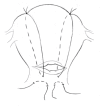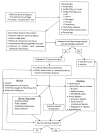Emergent management of postpartum hemorrhage for the general and acute care surgeon
- PMID: 19939251
- PMCID: PMC2788527
- DOI: 10.1186/1749-7922-4-43
Emergent management of postpartum hemorrhage for the general and acute care surgeon
Abstract
Background: Postpartum hemorrhage is one of the rare occasions when a general or acute care surgeon may be emergently called to labor and delivery, a situation in which time is limited and the stakes high. Unfortunately, there is generally a paucity of exposure and information available to surgeons regarding this topic: obstetric training is rarely found in contemporary surgical residency curricula and is omitted nearly completely from general and acute care surgery literature and continuing medical education.
Methods: The purpose of this manuscript is to serve as a topic specific review for surgeons and to present a surgeon oriented management algorithm. Medline and Ovid databases were utilized in a comprehensive literature review regarding the management of postpartum hemorrhage and a management algorithm for surgeons developed based upon a collaborative panel of general, acute care, trauma and obstetrical surgeons' review of the literature and expert opinion.
Results: A stepwise approach for surgeons of the medical and surgical interventions utilized to manage and treat postpartum hemorrhage is presented and organized into a basic algorithm.
Conclusion: The manuscript should promote and facilitate a more educated, systematic and effective surgeon response and participation in the management of postpartum hemorrhage.
Figures





Similar articles
-
Introduction.Ann Ital Chir. 2019;90:371-372. Ann Ital Chir. 2019. PMID: 31815733
-
Trauma care in German-speaking countries: have changes in the curricula led to changes in practice after 10 years?Eur J Trauma Emerg Surg. 2019 Apr;45(2):309-314. doi: 10.1007/s00068-017-0894-3. Epub 2018 Jan 6. Eur J Trauma Emerg Surg. 2019. PMID: 29306971
-
Association of Acute Care Surgeon Experience With Emergency Surgery Patient Outcomes and Mortality.JAMA Surg. 2021 May 1;156(5):472-478. doi: 10.1001/jamasurg.2021.0041. JAMA Surg. 2021. PMID: 33688932 Free PMC article.
-
Changing face of trauma and surgical training in a developing country: A literature review.J Pak Med Assoc. 2020 Feb;70(Suppl 1)(2):S89-S94. J Pak Med Assoc. 2020. PMID: 31981343 Review.
-
Postpartum hemorrhage: Anesthesia management.Semin Perinatol. 2019 Feb;43(1):35-43. doi: 10.1053/j.semperi.2018.11.007. Epub 2018 Nov 14. Semin Perinatol. 2019. PMID: 30578145 Review.
Cited by
-
Primary postpartum hemorrhage and associated factors among delivering women in Gedeo Zone, Southern Ethiopia.Front Med (Lausanne). 2023 Feb 14;10:1096501. doi: 10.3389/fmed.2023.1096501. eCollection 2023. Front Med (Lausanne). 2023. PMID: 36865062 Free PMC article.
-
Acute Care/Trauma Surgeon's role in obstetrical/gynecologic emergencies (The OBCAT Alert).World J Emerg Med. 2016;7(4):274-277. doi: 10.5847/wjem.j.1920-8642.2016.04.006. World J Emerg Med. 2016. PMID: 27942344 Free PMC article.
-
Optimizing transfusion strategies in damage control resuscitation: current insights.J Blood Med. 2018 Aug 20;9:117-133. doi: 10.2147/JBM.S165394. eCollection 2018. J Blood Med. 2018. PMID: 30154676 Free PMC article. Review.
-
Predictors of time to recovery from postpartum hemorrhage in Debre Markos comprehensive specialized hospital, Northwest, Ethiopia, 2020/21.BMC Pregnancy Childbirth. 2022 Jun 17;22(1):498. doi: 10.1186/s12884-022-04834-5. BMC Pregnancy Childbirth. 2022. PMID: 35715769 Free PMC article.
-
A rapid and effective approach to building a life-saving multidisciplinary team for transferred postpartum haemorrhage patients: leveraging trauma experience-a retrospective study.BMC Pregnancy Childbirth. 2025 Feb 11;25(1):137. doi: 10.1186/s12884-025-07204-z. BMC Pregnancy Childbirth. 2025. PMID: 39934707 Free PMC article.
References
-
- Pritchard JA, Baldwin RM, Dickey JC. Blood volume changes in pregnancy and the puerperium. II. Red blood cell loss and changes in apparent blood volume during and following vaginal delivery, cesarean section and cesarean section plus total hysterectomy. Am J Obstet Gynecol. 1962;84:1271–1282.
-
- Abou Zahr C, Royston E. Global Mortality: Global Factbook. Geneva: World Health Organisation; 1991.
-
- American College of Obstetrics and Gynecology practice bulletin. Clinical Management Guidelines for Obstetricians-Gynecologists number 76, October 2006: Postpartum Hemorrhage. Obstet Gynecol. 2006;108:1039–1047. - PubMed
LinkOut - more resources
Full Text Sources

